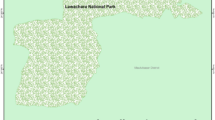Abstract
This study was undertaken the use of course and moderate spatial resolution remote sensing data to assess the forest degradation in the Peninsular Malaysia. Moderate Resolution Imaging Spectroradiometer (MODIS) imagery was used as coarse spatial resolution data, while Landsat Enhanced Thematic Mapper+ (ETM+) imagery was used as moderate spatial resolution to compare the accuracy. Geometric and radiometric correction and re-sampling were performed in pre-processing to enhance the analysis and results. Canopy fractional cover was used as an approach to assess the forest degradation in this study. Then, an optimum vegetation index was selected to apply on canopy fractional cover to enhance the detection of forest canopy damage. At the same time, accuracy assessment for the approach was referred to the location of Neobalanocarpus Heimii and correlate with global evapotranspiration rate. The forest degradation analysis was also applied and compared for all of the states in the Peninsular Malaysia. In conclusion, Landsat ETM+ imagery obtained higher accuracy compare to MODIS using canopy fractional cover approach for forest degradation assessment, and can be more broadly applicable to use for forest degradation investigation.











Similar content being viewed by others
References
Byg, A., & Salick, J. (2009). Local perspectives on a global phenomenon-Climate change in Eastern Tibetan villages. Global Environment Change, 19, 156–166.
Cemr, U. (2007). Detecting changes in multispectral satellite images using time dependent angle vegetation. Recent Advances in Space Technologies, 2007. RAST ‘07. 3rd International Conference. P: 345–348.
Charlton, M. B., & Arnell, N. W. (2011). Adapting to climate change impacts on water resources in England-Anassessment of draft Water Resources Management Plans. Global Environment Change, 21, 238–248.
Chen, T., Niu, R.-q., Li, P.-x., Zhang, L.-p., Du, B. (2010). Dynamic analysis of vegetation coverage change in Miyun Reservior basin from 2000 to 2005 based on remote sensing. International Symposium on Intelligence Information Processing and Trusted Computing. P: 33–36.
Defries, R. S., Hansen, M. C., & Townshend, J. R. G. (2000). Global continuous fields of vegetation characteristics: a linear mixture model applied to multi-year 8 km AVHRR data. International Journal Remote Sensing, 21, 1389–1414.
Hagerman, S., Dowlatabadi, H., Satterfield, T., McDaniels, T. (2010). Expert views on biodiversity conservation in an era of climate change. Global Environment Change, 20, 192–207.
Hagerman, S., Witter, R., Corson, C., Suarez, D., Maclin, E. M., Bourque, M., et al. (2012). On the coattails of climate? Opportunities and threats of a warming Earth for biodiversity conservation. Global Environment Change, 22, 724–735.
Jusoff, K., & Majid, N. M. (1990) Inventory and monitoring of forested-wetland resources of ASEAN. Journal of Forest Economic Management. Vol. 33–34.
Li, L., Ustin, S. L., & Lay, M. (2005). Application of AVIRIS data in detection of oil-induced vegetation stress and cover change at Jornada, New Mexico. Remote Sensing of Environment, 119, 62–71.
Liang, Z., Wu, B. F., Zhou, Y. M., Meng, J. H. et al. (2008) A study of fast estimateion of vegetation fraction three Gorges Emigration area by using SPOT5 imagery. The International Archives of the Photogrammetry, Remote Sensing and Spatial Information Sciences. Vol. XXXVII. Part B8. Beijing.
Luquet, D., Bégué, A., Vidal, A., Clouvel, P., Dauzat, J., Olioso, A., et al. (2003). Using multidirectional thermography to characterize water status of cotton. Remote Sensing of Environment, 84, 411–421.
Maas, S. J. (2000). Linear mixture modeling approach for estimating cotton canopy ground cover using satellite multispectral imagery. Remote Sensing of Environment, 72(3), 304–308.
Oon, H. (2008). Globetrotter Wildlife Guide Malaysia. New Holland Publishers. p. 11.
Peijun, D., Xingli, L., Wen, C., Yan, L., & Huapeng, Z. (2010). Monitoring urban land cover and vegetation change by multi-temporal remote sensing information. Mining Society of Technology, 20, 0922–0932.
Pour, B. A., Hashim, M., & van Genderen, J. (2013). Detection of hydrothermal alteration zones in a tropical region using satellite remote sensing data: Bau gold field, Sarawak, Malaysia. Ore Geology Reviews, 54, 181–196.
Soepadmo, E. (2001). The encyclopedia of Malaysia. Plants, 2, 22–35.
Stow, D. A., Hope, A., McGuire, D., Verbyla, D., Gamon, J., Huemmrich, F., et al. (2004). Remote sensing of vegetation and land-cover change in Arctic Tundra Ecosystems. Remote Sensing of Environment, 89, 281–308.
Townshend, J. R. G., Justice, C. O., Gurney, C., McManus, J. (1992). The effect of misregistration on the detection of vegetation change. IEEE Transactions on Electronic Engineers Geosciences and Remote Sensing, 30(5), 1054–1060.
Townshend, J. R. G., Bell, V., Desch, A., Havlicek, C., Justice, C., Lawrence, W. L., et al. (1995). The NASA Landsat pathfinder humid tropical deforestationproject. Land satellite information in the next decade. ASPRS conference, 25_28 September 1995, Vienna: American Society for Photogrammetry and Remote Sensing, VI, IV-76 to IV-87.
Townshend, J. R., Justice, C. O., Skole, D. L., Belward, A., Janetos, A., Gunawan, I., et al. (2004). Meeting the goals of GOFC. In G. Gutman et al. (Eds.), Land change science (pp. 31–51). Dordrecht: Kluwer Academic Publishers.
Townshend, J. R., Masek, J. G., Huang, C., Vermote, E. F., Gao, F., Channan, S., et al. (2012). Global characterization and monitoring of forest cover using Landsat data: opportunities and challenges. International Journal of Digital Earth, 5(5), 373–397.
Yang, J., Weisberg, P. J., & Bristow, N. A. (2012). Landsat remote sensing approaches for monitoring long-term tree cover dynamics in semi-arid woodlands: Comparison of vegetation indices and spectral mixture analysis. Remote Sensing of Environment, 119, 62–71.
Yonghai, Y., Anning, S., & Nan, J. (2011). Response of ecosystem service to landscape change in Panjin coastal wetland. Proceeding Earth Planetary Science, 2, 340–345.
Acknowledgments
This study is granted by Universiti Teknologi Malaysia (UTM). We also acknowledge Research Management Centre of UTM for facilitating the post-doctoral scheme. We also would like to express our great appreciation to the anonymous reviewers for their very useful and constructive comments and suggestions for improvement of this manuscript.
Author information
Authors and Affiliations
Corresponding author
About this article
Cite this article
Hashim, M., Pour, A.B. & Wei, C.K. Comparison of ETM+ and MODIS Data for Tropical Forest Degradation Monitoring in the Peninsular Malaysia. J Indian Soc Remote Sens 42, 383–396 (2014). https://doi.org/10.1007/s12524-013-0314-z
Received:
Accepted:
Published:
Issue Date:
DOI: https://doi.org/10.1007/s12524-013-0314-z




